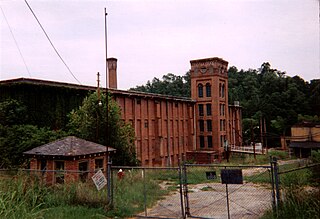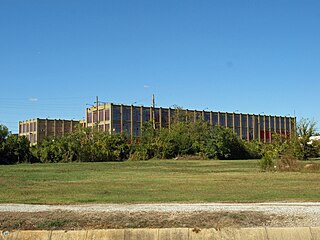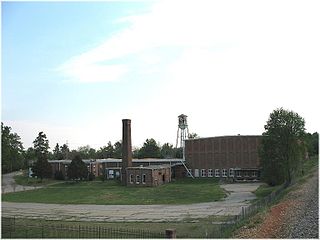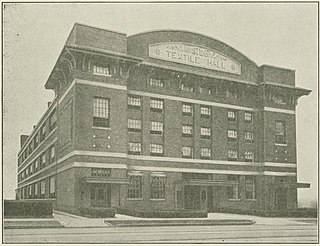
Seneca is a city in Oconee County, South Carolina, United States. The population was 8,102 at the 2010 census. It is the principal city of the Seneca Micropolitan Statistical Area, an (MSA) that includes all of Oconee County, and that is included within the greater Greenville-Spartanburg-Anderson, South Carolina Combined Statistical Area. Seneca was named for the nearby Cherokee town of Isunigu, which English colonists knew as "Seneca Town".

Harmony Mills, in Cohoes, New York, United States, is an industrial district that is bordered by the Mohawk River and the tracks of the former Troy and Schenectady Railroad. It was listed as Harmony Mills Historic District on the National Register of Historic Places in 1978. A portion of the district encompassing the industrial buildings and some of the housing built for millworkers was declared a National Historic Landmark in 1999. The centerpiece building, Harmony Mill No. 3 was listed on the National Register of Historic Places in 1971.

Newry is a census-designated place in Oconee County, South Carolina, United States. According to the 2010 United States Census, the population of the CDP was 172.

Piedmont Number One is a former textile plant and former National Historic Landmark in Piedmont, Greenville County, South Carolina. It burned in 1983.

Arcadia Mills No. 2, now the Mayfair Lofts, is a historic mill building at 100 W. Cleveland St., Spartanburg, South Carolina. It was listed on the National Register of Historic Places in 2005.

Mills Mill was a textile mill in Greenville, South Carolina (1897-1978) that in the 21st century was converted into loft-style condominia. The building is listed on the National Register of Historic Places.

Monaghan Mill, now the Lofts of Greenville, is a former textile mill (1900–2001) in Greenville, South Carolina, that in the early 21st century was converted into loft apartments. The building is listed on the National Register of Historic Places.

Isaqueena, also known as the Gassaway Mansion, is a historic house in Greenville, South Carolina, and the largest private residence in the Upstate. In 1982 it was listed in the National Register of Historic Places.

Erwin Mill was a textile mill in Durham, North Carolina that operated between the years of 1893 and 1986. After seeing the success of other cotton mills in the Northeast and locally in Durham, entrepreneur Benjamin N. Duke incorporated the mill in 1892 and recruited William H. Erwin to manage the enterprise. The mill's success in the late 19th and early 20th centuries was the result of Erwin's and his successors' exceptional management tactics, even when the factory hit obstacles such as the Great Depression and the unionization of its workers. The mill grew quickly in the late 19th century and early 20th century, became one of North Carolina's largest cotton mills. It originally produced muslin pouches for tobacco, but the mill would later expand its production to other fabrics, becoming one of the largest producers of denim in the world during the early 1900s. Workers at the mill enjoyed some of the best working conditions and highest wages in textile factories throughout the southern United States. Mill employees would later sign union-friendly labor agreements that were radical to the southern textile industry in the early to mid 20th century. The establishment of homes, businesses and recreation areas in the mill village was a significant factor in the development of the West Durham, especially the Ninth Street business district and the Old West Durham Neighborhood. Erwin Mill No. 1 is on the National Register of Historic Places and the mill village of West Durham is a National Historic District. An apartment complex, office building and shopping center of the same name that are built on the original site also commemorate the factory.

Woodside Cotton Mill Village Historic District is a national historic district located in Greenville County, South Carolina. The district encompasses 278 contributing buildings and 2 contributing sites in an early 20th century urban South Carolina textile mill village. Centered on a mill founded by John T. Woodside in 1902, the district is located just west of the city limits of Greenville and is largely intact despite modernizations made by a succession of mill and home owners. The mill itself is a rectangular, brick, four-story building designed by J.E. Sirrine and built between 1902 and 1912. Eventually the mill became the largest cotton mill under one roof in the United States and one of the largest in the world.

Drayton Mill is a historic textile mill complex located near Spartanburg, Spartanburg County, South Carolina. The complex includes the distinctive Tudor Revival company store and office building, constructed in 1919. Other buildings and structures include the three-story, rectangular, red brick spinning mill (1902-1904) with later additions, a cotton warehouse (1918), a two-story weaving building (1928), a 1,500,000 gallon mill pond, two water towers, two pump buildings, and an information center.

The Lincoln Mill and Mill Village Historic District is a historic district in Huntsville, Alabama. Opened in 1900, it quickly grew to be Huntsville's largest cotton mill in the first quarter of the 20th century. After closing in 1955, the mills were converted to office space that was used by the U.S. space program. Two of the older production buildings burned in 1980, but one main building and numerous houses built for workers remain. The district was listed on the National Register of Historic Places in 2010.

Buffalo Mill Historic District is a national historic district located at Buffalo, Union County, South Carolina. The district encompasses 190 contributing buildings and 2 contributing structures associated with the Buffalo Mill textile mill complex and mill village. The mill complex includes the main mill, mill office, power house, ice factory, mill warehouse, company store, and company bank/drug store. The main mill building features applied stylized Romanesque Revival detailing. The mill village housing varies from large, free-classic, Queen Anne style supervisor's houses, to shingle-style bungalows, to simple, one-story, workers residences. The village also includes a school and a baseball field/park.

The Lanneau-Norwood House is a historic, late 19th-century house on Belmont Avenue in Greenville, South Carolina. The house is an outstanding example of Second Empire architecture in the American South and is one of the last surviving Victorian-era homes in Greenville. The property was added to the National Register of Historic Places in 1982.

The Cocheco Mills comprise a historic mill complex in the heart of Dover, New Hampshire. The mills occupy a bend in the Cochecho River that has been site of cotton textile manufacturing since at least 1823, when the Dover Manufacturing Company supplanted earlier sawmills and gristmills. The present mill buildings were built between the 1880s and the early 20th century, and were listed on the National Register of Historic Places in 2014.

Easley Mill is a historic mill complex in Easley, South Carolina. The mill was the first of three built in Easley between 1899 and 1910. The main building was completed in 1900, and is a four-story brick structure designed by preeminent mill architects Lockwood, Greene & Co. It was built during a boom in the textile industry across the Southern United States; more than 70 mills were opened in South Carolina alone between 1895 and 1903. The mill met with immediate success, including large shipments for export to China. By 1907, the mill contained over 37,000 spindles and 1,000 looms, and employed 500. It was sold to Woodside Mills of Greenville in 1920, and to Dan River, Inc. in 1956, who operated the mill until 1990. The mill has a shallow-pitched hip roof with bracketed eaves. Most of the arched window openings have been bricked over. Other structures on the site include a one-story office building, a warehouse, smokestack, an ice house, water tower, and monument to the mill's founder, John Mattison Geer. The mill was listed on the National Register of Historic Places in 2013. A proposal was made to convert the building to apartments in 2019.

Sterling Cotton Mill, also known as the Franklinton Cotton Mill, is a historic cotton mill complex located at 108-112 East Green Street in Franklinton, Franklin County, North Carolina. The main mill is a one and two-story L-shaped brick building with Industrial Italianate style design elements. The mill consists of five sections: the original gabled one-story section rising to a two-story section at the east end (1895); a two-story addition (1914), a one-story addition (1960s); pre-1926 "cotton sheds"; and a small two-story brick office (1966). Associated with the mill is the contributing detached chimney stack. The mill was built by Samuel C. Vann, whose son Aldridge built the Aldridge H. Vann House. The mill closed in 1991.

Vardry Echols McBee was a saddlemaker, merchant, farmer, entrepreneur and philanthropist who has frequently been called the father of Greenville, South Carolina.
Eagley Mills is a complex of former cotton mills in Eagley, Bolton, England. The complex is adjacent to a model village originally built for the millworkers. The surviving mill buildings have since been converted to residential use.

Old Textile Hall was a former building in Greenville, South Carolina, which from 1917 to 1962, hosted the Southern Textile Exposition, a trade fair for textile machinery. The building also functioned as a municipal auditorium for Greenville until 1958. Old Textile Hall was listed on the National Register of Historic Places in 1980, but it was removed after the building was demolished in 1992.























